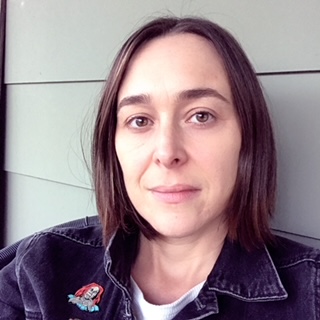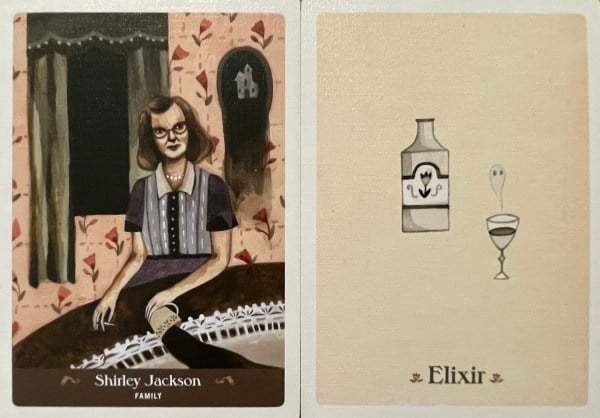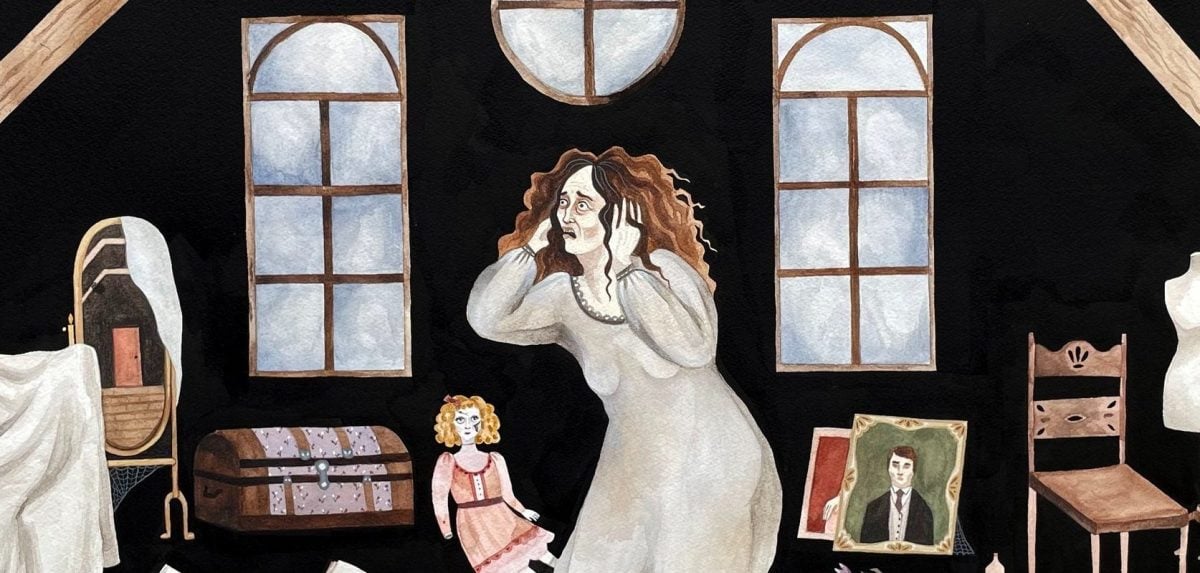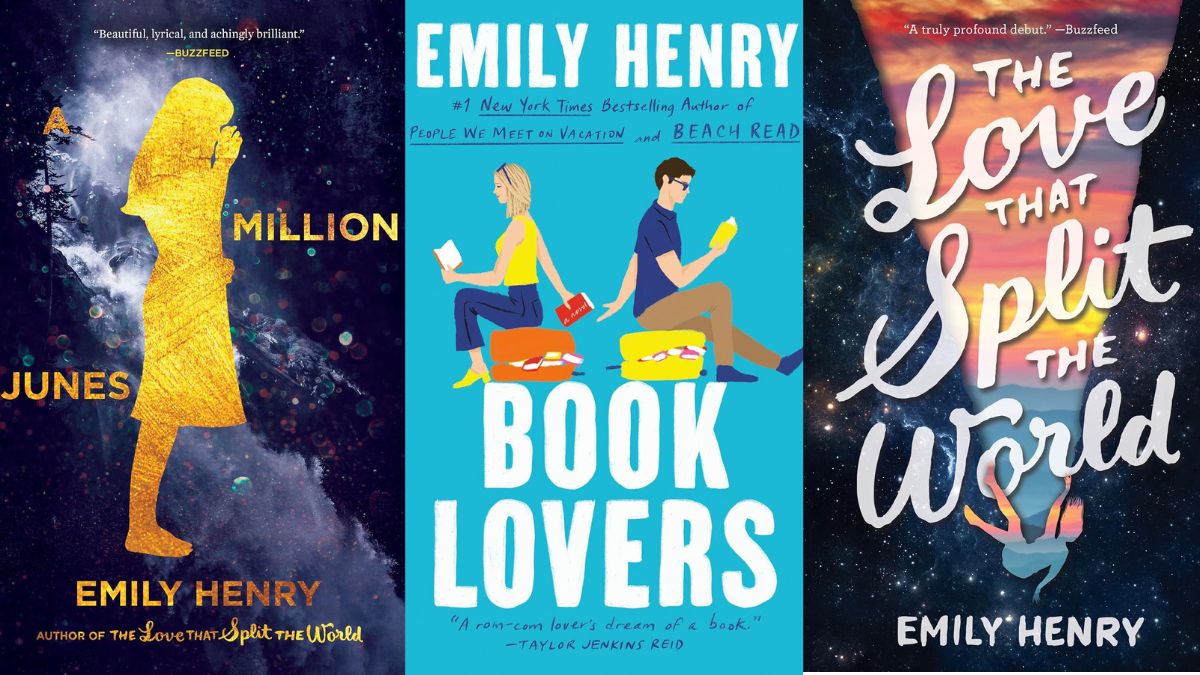A Victorian woman screams in despair. An Appalachian granny witch smokes her pipe. A ghost peeks in the window and disappears, leaving a murdered lamb in its wake. Enter the spooky, sumptuous world of artist and illustrator Katy Horan.
Horan is best known for Literary Witches: A Celebration of Magical Women Writers, the book and oracle deck she created with poet Taisia Kitaiskaia. Named one of NPR’s Best Books of 2017, Literary Witches consists of surrealist portraits of authors like Shirley Jackson and Octavia Butler, while the oracle deck includes illustrations of ghosts, elixirs, dresses, and other symbols.
Horan’s work has also been featured in solo shows and group exhibitions in her home of Austin, Texas, and beyond. After Roe v. Wade was overturned last June, Horan put out a social media call for anonymous abortion stories, the first of which was republished on Bust Magazine‘s Instagram page.
We recently spoke with Horan about her current projects, her artistic influences, and her fascination with all things spectral and spooky.

Julia Glassman (TMS): Your work is very much focused on folk horror, especially centering on women. What draws you to this subject?
Katy Horan: I love horror in general. I’ve been an active horror fan probably since I was 12. I’ve always been drawn to things that are dark, things that are spooky and weird, and when I started my work, that’s what I wanted to give back to people. I wanted to provide a similar experience. Folk horror is just that perfect blend of things I love—it’s spooky and weird, but it’s steeped in folklore, which is another interest of mine. There’s something about the intangible strangeness of folklore and folk horror that I’ve always wanted to try to bottle up and put into my work.
TMS: What kind of folklore are you drawn to in particular?
Horan: I like all manner of European folklore, especially from Eastern Europe, although I’ve spent the most time with Appalachian, Southern, and Ozark folklore. That’s really the only American folklore that I’m the most familiar with. It’s funny, because I’m from Texas, but I have no interest in things like Texas tall tales. They lack a certain darkness.
TMS: What’s your process for developing folklore into a drawing or painting?
Horan: My process can take a long time. I’ll go through these periods where I become fixated on a certain type of folklore. I’ll just read and read and read, or watch movies and listen to music, and I’ll absorb themes and symbols and imagery, like “chicken feet” or “tangled hair.” What’s really funny is that I’m not a big sketcher, but my sketchbook is full of words. I’ll write down any imagery that kind of pings my brain, and then, when I get into the creative process, all that random stuff will start coming together and form pictures in my head. Most of my pieces arrive in my brain fully formed.
TMS: How about influences from other artists? Who do you see as your influences?
Horan: Kiki Smith is huge for me. I love the way she’ll take one character from a fairy tale and explore them in every medium. I love how simple her imagery is, but then how multifaceted she is, and how steeped in archetype she is. I also love Käthe Kollwitz, a German printmaker in the really early 20th century. She reacted to what she saw in WWI, so there’s very intense imagery. It’s the only visual art I’ve seen that’s made me cry, because it’s things like mothers clutching children, crowds of people being beaten—the way she captures things with gesture, it’s just stunning. It’s so stunning.
I also love the lady surrealists, like Leonora Carrington and Remedios Varo. They’re pretty huge for me as well. You just gotta love a surrealist.
TMS: You’ve described your work as dealing with archetypes, and there was one series that was focused on the archetype of the Appalachian granny witch. What archetypes do you work with?
Horan: The witch is the big one. Starting in the late 2000s, I did a lot of work about witchcraft, paganism, and witches. Not the pointy hat witch—the deep-rooted witch archetype and her countless forms. I also did a series in 2011 responding to archetypes of women in Victorian culture, like widows, spinsters, and the hysterical woman. Although it feels weird calling them archetypes. For me they’re archetypes, but I don’t think Carl Jung would have called them that. These are women who are defined by their lack of a husband, and I found that really interesting. I’ve never been interested in the archetypes of the mother, wife, or daughter, all of the ones that I could personally identify with. I’m interested in the ones that are a little darker.
TMS: It’s interesting that the “darker” archetypes are the ones that are defined by their lack of a relationship to a man.
Horan: Isn’t that fascinating? And the thing with the widows is that they have a prescribed outfit to wear. You wear black for a year, and then you can wear mauve for six months. I found Victorian mourning practices to be a very strange, and visually very delicious, piece of history.
TMS: You mentioned how political Käthe Kollwitz’s work is, and I know you’ve produced some political work yourself, especially your recent Abortion Stories. How did those come about?
Horan: Well, Roe got overturned. When things happen—say, when there’s another shooting, or when something happens with civil rights, or when a politician does something awful, I try to respond with my work, because I know that’s something that I can do. I have a small platform, but it’s still a platform. Even when it’s coded in folklore, my work is feminist at heart.
With the Abortion Stories, I was trying to get to the root of what upset me so deeply about what was going on. So when Roe got overturned, and I was feeling devastated, I had this sudden idea to gather abortion stories.
TMS: I won’t pry into the details of people’s lives, but what has it been like, reading all the stories you received?
Horan: It’s funny, people tell me that it must be so hard to read all these stories, but it hasn’t been. The stoires have ranged from, “I didn’t want to be pregnant, so I got an abortion, and my boyfriend was cool about it and we got tacos, yay” to really some of the rougher, harder things that you can imagine.
But it hasn’t all been this heavy burden. I haven’t felt overwhelmed or upset by it. What I feel most is gratitude to the storytellers. A lot of them are anonymous, but the amount of time I spent breaking that first story down and storyboarding it—it became so intimate. I have such an intimate relationship to that story now, and I don’t know the person who wrote it. The whole point of the comics is to try and pull out the humanity in abortion, and for me it’s been a really beautiful experience so far.
TMS: One of the things I love about that first story is the geometric star shape you use to depict the clinic and the act of abortion itself. How did you arrive at that particular symbol?
Horan: You know, it was actually really hard, because I knew I didn’t want the imagery to be literal. When I first started, I felt so lost that I almost quit. I’m not interested in just drawing a building, or someone picking up a phone. I don’t know anything about the people sending me stories, so I knew they’d have to look ambiguous, and I thought, well, maybe I can use ambiguity throughout, so I started using the star symbols for the energy of the fetus that was terminated. You can communicate a lot with color and shape, and I felt like I was creating this alternate dimension, or this almost sci-fi landscape, and I felt like taking it out of our world helped me focus on the emotional core of it.
TMS: To shift gears, Monday’s Halloween, so I’d love to talk about Literary Witches. How’d that project come about?
Horan: Taisia found me on Tumblr years ago and got in touch with me, and it turned out we both happened to live in Austin. She was trying to turn her project, Ask Baba Yaga, into a book. My daughter had just been born and I was in a lull with my work, and I was trying to get more illustration work, but I couldn’t get my foot in the door anywhere. She emailed me about Baba Yaga, and that fell through [note: Ask Baba Yaga is now a 2-volume series], but we decided to meet anyway, and she told me about her idea for Literary Witches. The publisher wanted to make a tarot deck out of it, but Taisia knew that shoving it into the structure of the traditional tarot wasn’t going to work, so she came up with the oracle deck instead.

TMS: The deck is divided into the portraits of the authors, and then there are these more oracle-y object cards …
Horan: The Witches’ Materials.
TMS: Yes!
Horan: That was Taisia’s idea. She said, what if we consider the writers from the book the major arcana, and create our own minor arcana with symbols pulled from the book? She came up with the structure and meanings, and I drew them.
TMS: Was it fun to interpret her prompts?
Horan: Oh, yeah. Interpreting her writing for the book was incredible, because her writing is so weird. There was so much gorgeous imagery in her text to play with. I’d never collaborated with anyone else before, but we’re very mind-melded.
TMS: I know the abortion stories are your main project right now, but is there anything else you’re working on?
Horan: I’m working on some potential books, but I can’t talk about what they are. I can say they’ll be my first ever solo books.
This interview has been edited for length and clarity.
Correction: an earlier version of this article stated that Horan’s Abortion Stories are forthcoming in Bust Magazine. In actuality, Bust shared the first story on Instagram.
(featured image: Katy Horan)










Published: Oct 31, 2022 12:22 pm